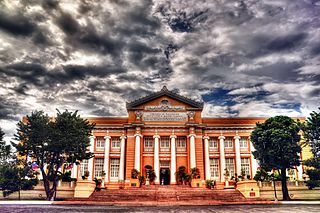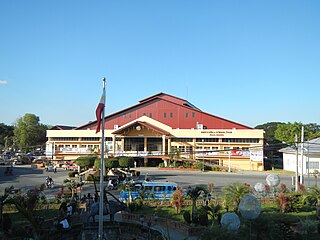
Tarlac, officially the Province of Tarlac, is a landlocked province in the Philippines located in the Central Luzon region. Its capital is the city of Tarlac, which is the most populous in the province. It is bounded on the north by the province of Pangasinan, Nueva Ecija on the east, Zambales on the west, and Pampanga in the south. The province comprises three congressional districts and is subdivided into 17 municipalities and one city, Tarlac City, which is the provincial capital.

La Union, officially the Province of La Union, is a province in the Philippines located in the Ilocos Region in the island of Luzon. Its capital is the City of San Fernando, which is the most populous in the province and also the regional center of the Ilocos Region.

The Ilocos Region, designated as Region I, is an administrative region of the Philippines. Located in the northwestern section of Luzon, it is bordered by the Cordillera Administrative Region to the east, the Cagayan Valley to the northeast and southeast, Central Luzon to the south, and the South China Sea to the west.

Malolos, officially the City of Malolos, is a 3rd class component city and capital of the province of Bulacan, Philippines. According to the 2020 census, it has a population of 261,189 people. It is the capital city of the province of Bulacan as the seat of the provincial government.

Sison, officially the Municipality of Sison, is a 3rd class municipality in the province of Pangasinan, Philippines. The town's original name was Alava. According to the 2020 census, it has a population of 52,320 people.

Pangasinan, officially the Province of Pangasinan, is a coastal province in the Philippines located in the Ilocos Region of Luzon. Its capital is Lingayen while San Carlos City is the most populous. Pangasinan is in the western area of Luzon along Lingayen Gulf and the South China Sea. It has a total land area of 5,451.01 square kilometres (2,104.65 sq mi). According to the 2020 census, it has a population of 3,163,190. The official number of registered voters in Pangasinan is 1,651,814. The western portion of the province is part of the homeland of the Sambal people, while the central and eastern portions are the homeland of the Pangasinan people. Due to ethnic migration, the Ilocano people settled in the province.

Aguilar, officially the Municipality of Aguilar, is a 3rd class municipality in the province of Pangasinan, Philippines. According to the 2020 census, it has a population of 45,100 people.

Bugallon, officially the Municipality of Bugallon, is a 2nd class municipality in the province of Pangasinan, Philippines. According to the 2020 census, it has a population of 74,962 people.

Lingayen, officially the Municipality of Lingayen, is a 1st class municipality and capital of the province of Pangasinan, Philippines. According to the 2020 census, it has a population of 107,728 people.

Pozorrubio, officially the Municipality of Pozorrubio, is a 1st class municipality in the province of Pangasinan, Philippines. According to the 2020 census, it has a population of 74,729 people.

Rosales, officially the Municipality of Rosales, is a 1st class municipality in the province of Pangasinan, Philippines. According to the 2020 census, it has a population of 66,711 people.

San Nicolas, officially the Municipality of San Nicolas, is a landlocked, 1st class municipality in the province of Pangasinan, Philippines. According to the 2020 census, it has a population of 39,778 people.

The Philippine Republic, now officially remembered as the First Philippine Republic and also referred to by historians as the Malolos Republic, was established in Malolos, Bulacan during the Philippine Revolution against the Spanish Empire (1896–1898) and the Spanish–American War between Spain and the United States (1898) through the promulgation of the Malolos Constitution on January 23, 1899, succeeding the Revolutionary Government of the Philippines. It was formally established with Emilio Aguinaldo as president. It was unrecognized outside of the Philippines but remained active until April 19, 1901. Following the American victory at the Battle of Manila Bay, Aguinaldo returned to the Philippines, issued the Philippine Declaration of Independence on June 12, 1898, and proclaimed successive revolutionary Philippine governments on June 18 and 23 of that year.

Saints Peter and Paul Parish Church, commonly known as Calasiao Church, is a Baroque church located in Poblacion West, Calasiao, Pangasinan, Philippines. It belongs to the Vicariate of Sts. Peter and Paul under the Ecclesiastical Province of the Roman Catholic Archdiocese of Lingayen-Dagupan. The 57,840 Catholics is under the pastoral care of Rev. Fidelis B. Layog, assisted by Rev. Isidro Palinar, Jr. and Rev. Raymund Manaois.

The Pangasinan Provincial Capitol, on Lingayen Gulf, is the present seat of the government of Pangasinan. It was declared as one of the eight Architectural Treasures of the Philippines by the National Commission for Culture and the Arts. Located in Lingayen, this government building was constructed during the term of the late Governor Daniel Maramba, the "Grand Old Man of Pangasinan". On the central concave portion of its façade reads, an inscription says, "Province of Pangasinan. Erected Capitol Building AD MCMXVIII by the Government and Administration of Civil State promoting Life, Liberty, and Pursuit of Happiness."

The Narciso Ramos Sports and Civic Center (NRSCC), also known as the Narciso Ramos Sports Complex, is a complex of sports facilities in Lingayen, Pangasinan.

The Governor of Iloilo is the local chief executive of the Philippine province of Iloilo. The governor holds office at the Iloilo Provincial Capitol located at Bonifacio Drive, Iloilo City. Like all local government heads in the Philippines, the governor is elected via popular vote, and may not be elected for a fourth consecutive term. In case of death, resignation or incapacity, the vice governor becomes the governor. Along with the governors of Aklan, Antique, Capiz, andGuimaras, he sits in the Regional Development Council of the Western Visayas Region.
"Luyag Ko Tan Yaman", also known by its Filipino title "Pangasinan Aking Yaman", and generally referred to as the Pangasinan Hymn, is the official anthem of the province of Pangasinan in the Philippines.

The Casa Real de Iloilo, also known as the Old Iloilo Provincial Capitol, was the seat of the provincial government of Iloilo in the Philippines since the Spanish colonial period until 2006. It also served as the residence of the alcalde-mayor, presidente municipal, or governor, who held the highest authority as the Spanish official in Iloilo during the period.

The Iloilo Provincial Capitol is the seat of the provincial government of Iloilo in the Philippines.





















